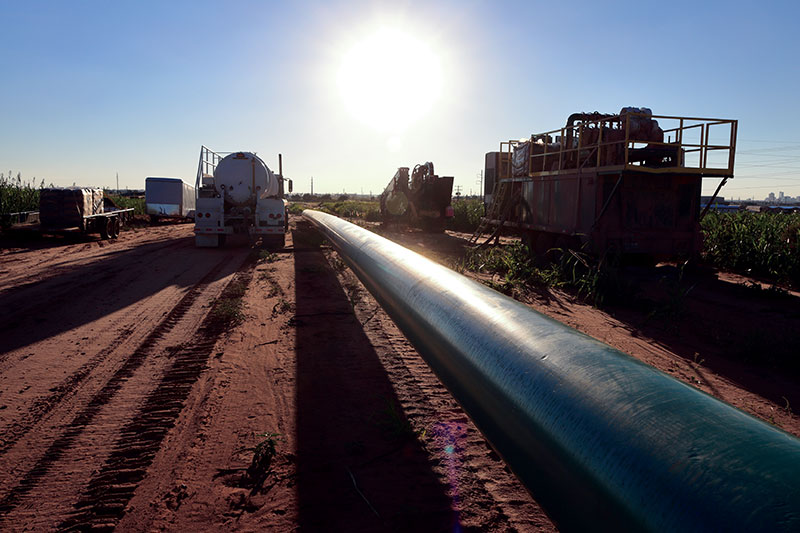September 2020, Vol. 247, No. 9
Permian Update
Permian Enters Uncharted Waters in Better Shape than Most Regions
By Michael Reed, Editor-in-Chief
With the Coronavirus crisis and its effect on upstream operations putting a damper on all segments of the midstream sector, some major projects in the Permian Basin appear to be moving forward, albeit at a slower and far more cautious pace.
Among those is the 1-MMbpd crude oil and condensate Wink-to-Webster Pipeline, a joint venture between affiliates of Exxon Mobil, Plains All American and MPLX. The 650-mile (1,046-km) pipeline will transport 1 MMbpd crude oil and condensate from the Permian Basin to the Texas Gulf Coast. When completed, most likely in the first half of 2021, the project will be supported by a significant volume of long-term commitments.
Additionally, Whitewater Midstream and MPLX secured funding in June to construct the 500-mile (804-km) Whistler natural gas pipeline, which the companies still expect to begin operations on schedule during the third quarter of 2021. When completed it will provide a much-needed boost of 2 Bcf/d (57 MMcm/d) in capacity from the basin to the Agua Dulce area of South Texas.
On another fairly bright note, all things considered, the equally anticipated 450,000-bpd Midland-to-Echo 3 crude oil pipeline from Enterprise Products Partners is expected to begin service in late September.
Still, while the Permian is faring better than most other producing regions overall, there are indications that several other Permian projects have had more severe alterations to their construction schedules due to the coronavirus and the downturn in prices. Among these are the 650-mile (1,046-km), 36-inch (914-mm) Permian-to-Brownsville Jupiter Pipeline and the Plains/Delek 150,000-bpd Red River expansion – neither of which had begun construction in early August.
With originating points near Crane and Gardendale, Texas, the Jupiter Pipeline would be the only pipeline from the Permian with access to three deep water ports, Houston, Corpus Christi and Brownsville, as well as a loading facility off the Brownsville coast, capable of handling very large crude carriers (VLCC).
Delek’s Red River expansion between Cushing, Okla., and Longview, Texas, would increase capacity by 85,000 bpd to 235,000 bpd, allowing the company to cut its reliance on Midland-sourced crude oil.
Among the most prominent players in the Permian Basin, Kinder Morgan reported uncertainties as well, saying as far back as March that its proposed 2-Bcf/d Permian Pass natural gas pipeline in Texas faced difficulties moving forward because no customers had signed on due to low prices in the market.
Additionally, Kinder Morgan’s Permian Highway (PHP) gas pipeline – which late last year, prior to the pandemic, had its in-service date pushed back to early 2021 – now may be delayed further. Unlike Permian Pass, however, this 2.1-Bcf/d (59-MMcm/d) pipeline is fully subscribed under long-term contracts.
The PHP, after overcoming a recent legal challenge, will deliver Permian gas closer to the center of Kinder Morgan’s system to meet liquefied natural gas (LNG) and industrial demand in the Freeport, Texas, area.
Additionally, Kinder Morgan recently placed the 2-Bcf/d Gulf Coast Express (GCX) pipeline in service ahead of schedule. It transports Permian gas to the Ague Dulce/Corpus Christi area.
Midstream setbacks aside, the Permian remains the biggest U.S. production area for crude oil and the second biggest for gas. Prior to the downturn, production in the basin was expected to reach record highs during the year.
The most recent Wood Mackenzie North America Crude Markets Service long-term outlook foresees rapid buildout in the early 2020s, involving additional Permian-to-Gulf Coast pipeline capacity. The analysis indicates 300,000 bpd to 500,000 bpd of crude takeaway capacity will be required.
Further supporting that idea has been ongoing activity in the Sabine, Texas, area, which historically has been a growing market for liquefaction and LNG export. Houston-based Cheniere Energy is expanding liquefaction capacity at its export facilities on the Louisiana side of the Sabine River, while an Exxon Mobil-Qatar Petroleum joint venture is expanding its export terminal on the Texas side. San Diego-based Sempra Energy also is building an export terminal in nearby Port Arthur, Texas.
Natural gas pipeline projects and construction between the Permian Basin and the Gulf Coast is expected to continue, if at a slightly reduced rate, at least through 2021, despite some delays. This will coincide with the ongoing development of storage and export infrastructure for crude oil and LNG.
Among other Permian-related pipelines that have either come on line recently or are expected to begin service soon are the following:
- Enterprise Products added 200,000 bpd of capacity from the Permian Basin to Houston with the conversion of its Seminole-Red natural gas liquids (NGL) pipeline to crude oil in early 2019.
- Energy Transfer Partners’ Permian Express 4 expansion was scheduled to add 120,000 bpd when it begins service by the end of August.
- Plains All American began shipping crude for Trafigura Trading through the 670,000-bpd Cactus II Pipeline in early August, marking the first confirmed shipments on Plains’ newly operational system. The line was expected to flow about 300,000 bpd during its first month of operation and be near capacity in September.
- Epic Midstream Holdings recently began filling its 900,000-bpd EPIC Crude pipeline, originating in Orla, Texas. The system includes eight terminals and will serve the Delaware, Midland and Eagle Ford basins.
- The 850-mile (1,368-km) Gray Oak Pipeline, also with a capacity of 900,000 bpd, began operations in July, supplying the first crude oil into the South Texas Gateway Terminal. It will also connect to market centers in Sweeny and Freeport, Texas.






Comments